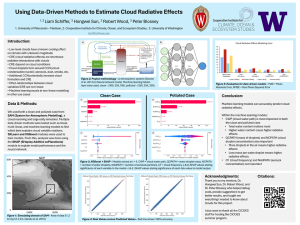
Liam Schiffer
University of Wisconsin-Madison
Research Mentor: Hongwei Sun
Project: Using Data-Driven Methods to Estimate Cloud Radiative Effects
Hi, my name is Liam Schiffer. I am a rising junior at the University of Wisconsin-Madison studying atmospheric and oceanic sciences. During my time in the CICOES summer program, I worked with my mentor Hongwei Sun, and co-hosts Robert Wood and Peter Blossey. My project was focusing on data driven methods to learn more about the radiative effects of clouds.
Cloud conditions and cloud formation processes potentially have a huge influence on climate by causing a cooling effect. Geoengineering through cloud seeding could alleviate rising global temperatures by increasing the amount of solar radiation reflected back into space. The technique my project looked at was marine cloud brightening, which uses natural aerosols the ocean produces to increase cloud formation over the ocean.
At first, my focus was familiarizing myself with SAM (System for Atmospheric Modeling), a cloud resolving and large eddy model which was used throughout the project. I looked at how different cloud condition variables, like the quantity of water droplets, water content, water droplet mass, aerosols, and clouds themselves were spatially located. This then shifted to learning how to use statistics to figure out relationships between variables through techniques like linear/multi-linear regression. Then, I tried my hand at modeling cloud radiative effects using higher degree functions.
Once I was familiarized with these methods, I then learned the basics of machine learning such as how a neural network functions, what machine learning method is right for my project, and different parameters. From here, I fine tuned the models as I used both the SKLearn and XGBoost machine learning modules to try different approaches to predicting cloud radiative effects. To help analyze the machine learning models, I used SHAP (SHapley Additive exPlanations). This module gives a value that describes how important a data point and variable are in the model. I used this to figure out which cloud variables are most important towards cloud radiative effects. I then worked on continuing to improve the models by trying different things like decreasing resolution, changing which variables I include in the model, and changing the size of the neural network.
This program gave me a lot of opportunities to learn both professional and networking skills. I had a great time getting to know the other interns and learn new things from them. The coding and statistics I learned this summer are skills I will likely use far into my career. I had a great time in Seattle and at the University of Washington, and I want to thank my mentors and CICOES for an awesome summer experience.

